外研版高中英语必修一第四模块教学设计.doc
- 格式:doc
- 大小:67.00 KB
- 文档页数:8
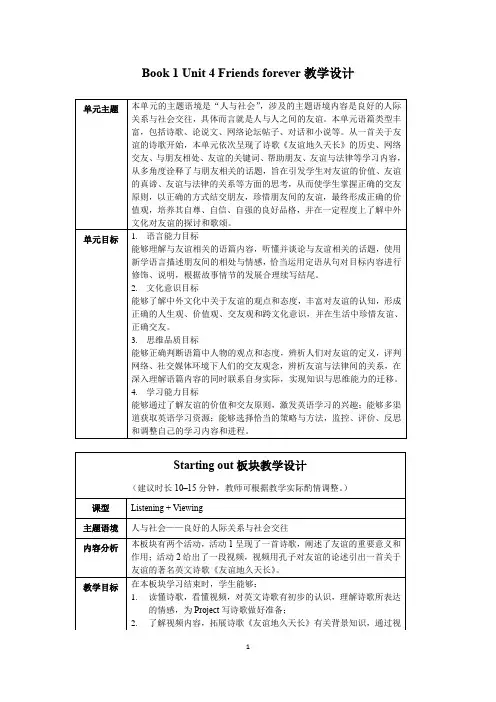

Module 4 A Social Survey-MyNeighborhood本模块主要是通过社会调查这个方法来使学生关注自己生活的社区及其发展,培养学生热爱家乡的意识和社会责任感。
该教学模块安排有描写居家的两篇短文,介绍Xiamen 的一篇文章,介绍社区的一篇听力材料,文化角部分是介绍西欧农村的阅读文章,以及围绕主题的一些口语和写作活动,学习的语法项目是现在完成时。
通过处理相关的知识点和重点词汇短语,可以帮助学生充实课文的学习;后面加上适当的讨论,巩固学习的效果并且培养学生的合作意识,以此为基础再设计安排一些语法学习和写作,培养他们的综合技能,为以后的学习作良好的铺垫。
1. 掌握描写社区的词汇和相关表达;2. 学会介绍和描绘自己的家;3.. 写作关于社区的报告;【教学重点】1. 学习和掌握本课生词。
2. 让学生掌握易混淆时态,如:现在完成时和一般过去时的区别。
【教学难点】1. 多层次的训练阅读能力,提高阅读水平2. 怎样让学生灵活使用词汇、短语和句型来做题。
Step 1 Introduction1. Lead-inBefore opening the books, think about the neighborhood you live in. Try to think out as many words as possible about buildings. Then the teacher asks the students : Do you want to have your own houses? Try to say something about your own houses!stone, bricks, high-rise building, apartment, floor, stone…2.Then the teacher gives them some pictures to show the words, to make the students familiar with these words about neighborhood.Read the words in Activity 1.Now tell me which words do you use to describe buildings?3. Use JIGSAW reading to do the exercise 2 in page 31.Tell us which one is more similar to yours.What kind of home do you like? Why?Two passages about the homes of two students.Ss in Row 1, 3, 5, 7, 9 got Paper A,Ss in Row 2, 4, 6, 8, 10 got Paper B.A +B = the two complete passageswork in pairsTalk but don’t show your paper to your partner.Language points:1) sixteen-year-old Zhang Huaa five-storey apartment blockthe house is two storeys high2) in the south of Chinain the northeast of the cityStep 2 Reading1.pre-readingAsk the students to think about Which city does the picture show?。
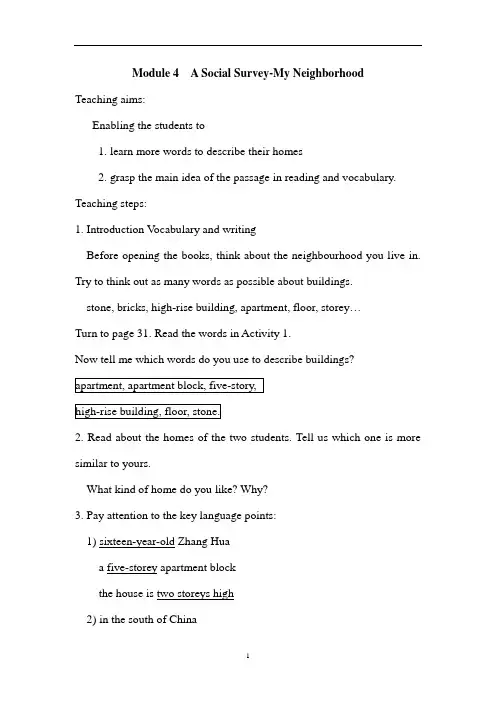
Module 4 A Social Survey-My Neighborhood Teaching aims:Enabling the students to1. learn more words to describe their homes2. grasp the main idea of the passage in reading and vocabulary. Teaching steps:1. Introduction V ocabulary and writingBefore opening the books, think about the neighbourhood you live in. Try to think out as many words as possible about buildings.stone, bricks, high-rise building, apartment, floor, storey…Turn to page 31. Read the words in Activity 1.Now tell me which words do you use to describe buildings?2. Read about the homes of the two students. Tell us which one is more similar to yours.What kind of home do you like? Why?3. Pay attention to the key language points:1) sixteen-year-old Zhang Huaa five-storey apartment blockthe house is two storeys high2) in the south of Chinain the northeast of the city4. Turn to page 32. Reading and V ocabulary.First look at the picture. Do you know where this place is?Have you ever been to Xiamen or have you heard Xiamen?What do you know about it?Suppose I want to know something about a city. What should you tell me about it?Listen to the tape of the text and make a note of what you think is important about Xiamen.5. Read the passage and answer the following questions:1.) Who is visiting whose hometown?2.) Where does Xiao Li live?3.) What’s the climate/weather like there?4.) Which district is the most interesting part of Xiamen?5.) What is Gulangyu Island like?6. Try to finish Activity 1 and Activity 2.7. Read the text again and try to say something about the livelycity-Xiamen.8. Ask some to tell about the city with the help of this clue.hometown→beautiful cities→friendly →fortunate→climate→apartment→business district→shopping malls→dress →present→harbor→district→island→restaurant.9. Homework:1) Read the passage several times to get more familiar with the information in it.2) Try to retell about the city.。
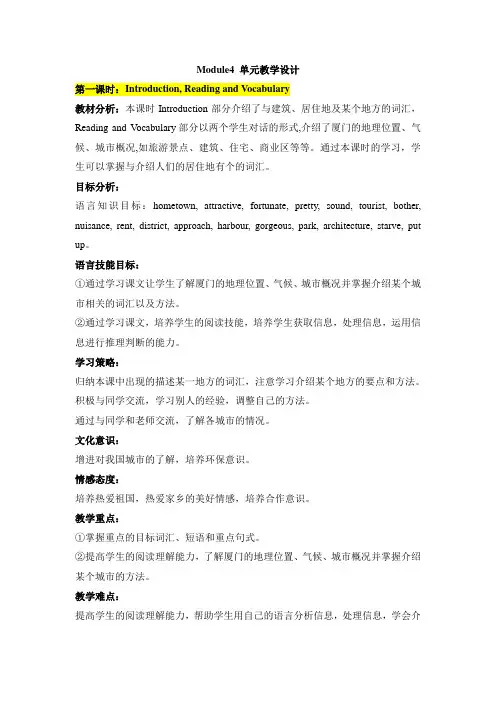
Module4 单元教学设计第一课时:Introduction, Reading and Vocabulary教材分析:本课时Introduction部分介绍了与建筑、居住地及某个地方的词汇,Reading and V ocabulary部分以两个学生对话的形式,介绍了厦门的地理位置、气候、城市概况,如旅游景点、建筑、住宅、商业区等等。
通过本课时的学习,学生可以掌握与介绍人们的居住地有个的词汇。
目标分析:语言知识目标:hometown, attractive, fortunate, pretty, sound, tourist, bother, nuisance, rent, district, approach, harbour, gorgeous, park, architecture, starve, put up。
语言技能目标:①通过学习课文让学生了解厦门的地理位置、气候、城市概况并掌握介绍某个城市相关的词汇以及方法。
②通过学习课文,培养学生的阅读技能,培养学生获取信息,处理信息,运用信息进行推理判断的能力。
学习策略:归纳本课中出现的描述某一地方的词汇,注意学习介绍某个地方的要点和方法。
积极与同学交流,学习别人的经验,调整自己的方法。
通过与同学和老师交流,了解各城市的情况。
文化意识:增进对我国城市的了解,培养环保意识。
情感态度:培养热爱祖国,热爱家乡的美好情感,培养合作意识。
教学重点:①掌握重点的目标词汇、短语和重点句式。
②提高学生的阅读理解能力,了解厦门的地理位置、气候、城市概况并掌握介绍某个城市的方法。
教学难点:提高学生的阅读理解能力,帮助学生用自己的语言分析信息,处理信息,学会介绍某个城市。
教学方法:新课程提倡运用任务型教学途径,围绕核心问题,设定小任务;围绕文章内容,尽可能提供训练学生技能的机会;开展自主性学习的课堂活动,强调合作探究与独立思考相结合。
这节课本人主要采用任务型教学法,借助多媒体展开教学活动。

Module 4 A Social Survey-My NeighbourhoodⅠ.The General Idea of This ModuleThe tasks of Module 4 are about how to get to know and introduce some places.Through oral practice,enable the students to introduce what they see and what they hear and describe them in writing.INTRODUCTIONLearn and master some words and phrases about buildings and living places.In order to prepare for the activities later,the task is to get the students to understand the words and phrases.READING AND VOCABULARYThrough the dialogue,the geography place of Xiamen is introduced,including its climate and a survey of the city of Xiamen.Enable the students to grasp the words and use them to describe their living places.GRAMMAR 1Learn how to use the perfect present tense:The actions happened in the past,but the effects or results still remain now.LISTENING AND VOCABULARYPractice using the words and phrases,train the students’ listening ability and test the results of listening.GRAMMAR 2The importance of Grammar 2 is about the differences between continuous verbs and discontinuous verbs and how to use them in the Present Perfect Tense.First make sure the students clear what is a continuous verb and what is not a continuous verb. Fox example,He has come here.He has been here for two hours.Here“come” is not a continuous ver b. But “be” is a continuous ver b.PRONUNCIATIONThis part is to improve the students’ pronunciation.Stress is important in speaking English.The students should master Parts of Speech.Generally speaking,the National Parts have stress in a sentence.But the Structural Parts don’t have.WRITINGThrough observing and writing,make sure that the students can use the words and and but.EVERYDAY ENGLISHIn the part the students practice using seven pieces of everyday English.During teaching, practice using them in conscious or unconscious.FUNCTION AND SPEAKINGThe students should learn and master how to introduce directions and places in English in this part.CULTURAL CORNERIncrease the students’ interests to know something about the life in western countries.TASKSThrough the practice of dialogue and reading,the students should be able to master some useful words and expressions about describing buildings and surroundings.In order to cultivate the students’ ability of collecting and dealing with information,and develop theirabilities in getting new information,communication and cooperation,the tasks are about a survey of their living situation and they are also asked to write a report in English.Ⅱ.Three-Dimensional Goals1.Knowledge and Skills:2.Through introducing some places, develop the students’ abilities to take active part in different activities. Train the ability of collecting and dealing with information, and develop their abilities of getting new information, communication and cooperation.3. Process and MethodsFirst lead the students to make dialogues about different buildings and facilities. Then ask the students to survey their living places and write down what they see and hear to improve the students’ speaking and writing abilities.4. Emotion, Attitude and V alue in TeachingLet students know the society, develop the students to care for the people around them and the society. Cultivate their ability of studying and solving questions.Ⅲ.Teaching Important PointsIn this module, through practicing listening, speaking and reading, the students will be able to get to know and introduce some places. Educa te the students’ cultural awareness and enable them to love our hometown and our homeland.Ⅳ.Teaching Difficult PointsHow to teach the Present Perfect Tense during teaching process.Ⅴ.Teaching Aidsmultimedia, a TV set or a recorderⅥ.Teaching TimeSeven periodsThe First Period: Introduction: V ocabulary and SpeakingThe Second and Third Period: Reading and V ocabularyThe Fourth Period: Grammar 1, Listening and V ocabularyThe Fifth Period: Pronunciation, Grammar 2 and WritingThe Sixth Period: Everyday English, Function and SpeakingThe Seventh Period: Cultural Corner, Task and Module and Workbook ExercisesThe First PeriodThe General Idea of This PeriodThe students will be able to learn some new words and phrases. And try to use them to describe buildings.Teaching Aims1. The students will be able to learn and master the following words and phrases:flat apartment block countryside five-storey high-rise building local mile floor suburb stone survey be similar to live with sb. / sth neighbourhood2. Improve the students’ speaking’ ability.3. Learn to describe some buildings and places.Teaching Important Points1. Master the new words and phrases.2. How to use “and” and “but”.3. Enable the students to write a brief report of their neighbourhood.Teaching Difficult Points1. How to use “and” and “but”.2. How to improve the students’ writing ability.Teaching Methods1. Asking and answering activity to help the students go through the reading materials.2. Individual, pair or group work to make every student work in class.Teaching ProceduresStep 1 Greetings and lead inT: Good morning, boys and girls.S: Good morning, teacher.T: Sit down please. Boys and girls, let’s see two p ictures.(Show the pictures)T: Please tell me something about the pictures?S: One is about the buildings in cities. The other is the countryside.T: Yeah. Which one is more beautiful? Why?S: I think the right one is. It is modern.T: How many floors do you guess the big one has?S: I guess it’s about 80.T: Do you agree?S: No. I think it’s about 30.T: If possible, which floor do you want to live in?S: The top one.T: The top one? Why?S: Live there, I can see the whole city.T: Try. I think you can one day.Step 2 PresentationNow let’s look at these words.(Show)1. Get one to read the words. Check his or her pronunciation and stress.2. Get the students to pay attention to the new words.(1) survey n.The group made a survey of the life in the countryside.The experts made a survey of the site of the prospective steel works.The report gives a survey of growth of the chemical industry.The market __________shows the new products have good potential if they are well developed.A. madeB. supportC. surveyD. examine答案:C。
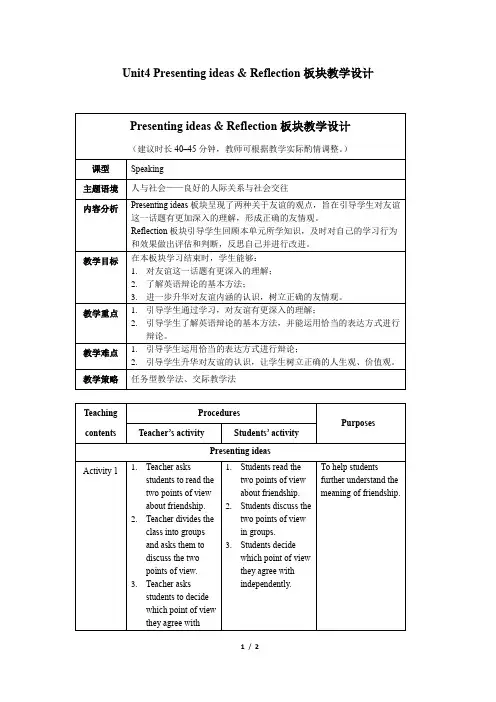
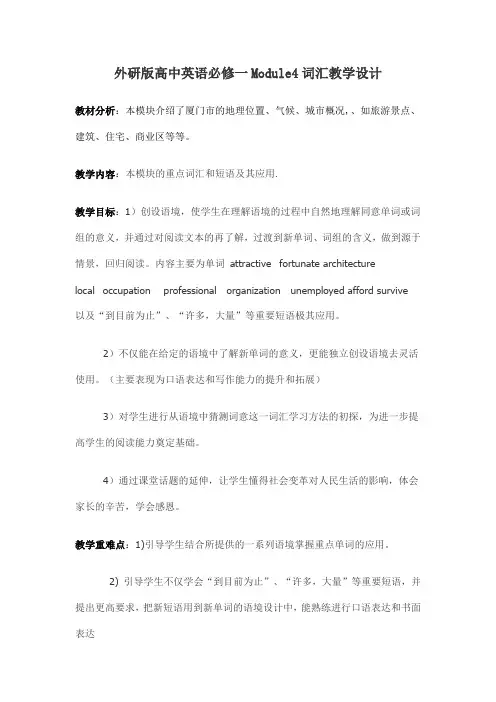
外研版高中英语必修一Module4词汇教学设计教材分析:本模块介绍了厦门市的地理位置、气候、城市概况,、如旅游景点、建筑、住宅、商业区等等。
教学内容:本模块的重点词汇和短语及其应用.教学目标:1)创设语境,使学生在理解语境的过程中自然地理解同意单词或词组的意义,并通过对阅读文本的再了解,过渡到新单词、词组的含义,做到源于情景,回归阅读。
内容主要为单词attractive fortunate architecturelocal occupation professional organization unemployed afford survive 以及“到目前为止”、“许多,大量”等重要短语极其应用。
2)不仅能在给定的语境中了解新单词的意义,更能独立创设语境去灵活使用。
(主要表现为口语表达和写作能力的提升和拓展)3)对学生进行从语境中猜测词意这一词汇学习方法的初探,为进一步提高学生的阅读能力奠定基础。
4)通过课堂话题的延伸,让学生懂得社会变革对人民生活的影响,体会家长的辛苦,学会感恩。
教学重难点:1)引导学生结合所提供的一系列语境掌握重点单词的应用。
2) 引导学生不仅学会“到目前为止”、“许多,大量”等重要短语,并提出更高要求,把新短语用到新单词的语境设计中,能熟练进行口语表达和书面表达教学设计:一、设计说明学生在进入本课学习之前,已经对于这一模块有了大概的了解与认识,学生此时已经对这些词汇词组有了基本的认知基础,因此,本节课打算充分利用前课的基础,为学生创设更多的语境,充分发挥他们的想象力,不仅学会目标单词、词汇和短语的意思,更懂得在语境中运用。
由于本单元语境鲜明,因此,学生利用语境猜测出意思不是难点,真正的难点是学生根据句型,结合本节课所提到的单词,自己创设语境,并口头和书面表达。
因此这节课我的设计意图非常明显,就是要求学生抓住语境不放,根据语境,不仅理解目标词汇和短语的意思,更能在句型的帮助下自主创设语境,进行初步的词句写作操练。

教师学科教案[ 20 – 20 学年度第__学期]任教学科:_____________任教年级:_____________任教老师:_____________xx市实验学校Module 4A Social Survey—My Neighbourhood本课时编写:马鞍山二中郑蒲港分校朱惠Lesson 1 Introduction教材分析:This module mainly helps students have a good understanding of their neighbourhood and know give a brief report of their neighbourhood. This lesson focuses on talking about neighbourhood and students are required to describe their homes.教学目标:By the end of this lesson, students will be able to:(1)learn words and expressions related to neighbourhood;(2)describe their homes;(3)learn to appreciate their homes and raise awareness of improving it.教学重难点:Students describe their homes by using the new words and expressions.课前准备:Multimedia教学过程:Step 1 Warm-upLook at the words in the box. Which words do you use to describe buildings?【设计意图】本单元的话题是关于学生所处的街区,该步骤意在导入与街区相关的词汇,帮助学生在后面的环节更好的输出。
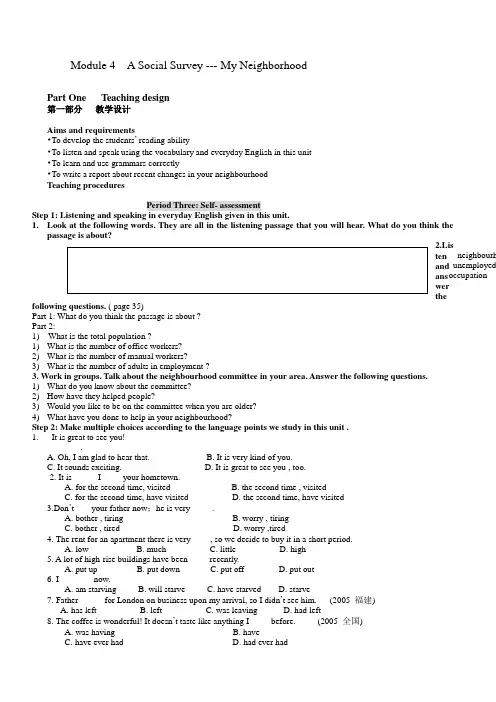
Module 4 A Social Survey --- My NeighborhoodPart One Teaching design第一部分 教学设计Aims and requirements•To develop the students ’ reading ability•To listen and speak using the vocabulary and everyday English in this unit•To learn and use grammars correctly•To write a report about recent changes in your neighbourhoodTeaching proceduresPeriod Three: Self- assessmentStep 1: Listening and speaking in everyday English given in this unit.1. Look at the following words. They are all in the listening passage that you will hear. What do you think the passage is about?2.Lis tenandans werthefollowing questions. ( page 35)Part 1: What do you think the passage is about ?Part 2:1) What is the total population ?1) What is the number of office workers?2) What is the number of manual workers?3) What is the number of adults in employment ?3. Work in groups. Talk about the neighbourhood committee in your area. Answer the following questions.1) What do you know about the committee?2) How have they helped people?3) Would you like to be on the committee when you are older?4) What have you done to help in your neighbourhood?Step 2: Make multiple choices according to the language points we study in this unit .1. --- It is great to see you!--- ______ .A. Oh, I am glad to hear that.B. It is very kind of you.C. It sounds exciting.D. It is great to see you , too.2. It is _____ I ____ your hometown.A. for the second time, visitedB. the second time , visitedC. for the second time, have visitedD. the second time, have visited3.Don ’t ___ your father now ;he is very ____ .A. bother , tiringB. worry , tiringC. bother , tiredD. worry ,tired4. The rent for an apartment there is very ____, so we decide to buy it in a short period.A. lowB. muchC. littleD. high5. A lot of high-rise buildings have been ____ recently.A. put upB. put downC. put offD. put out6. I ____ now.A. am starvingB. will starveC. have starvedD. starve7. Father _____ for London on business upon my arrival, so I didn ’t see him. (2005 福建)A. has leftB. leftC. was leavingD. had left8. The coffee is wonderful! It doesn ’t taste like anything I ____ before. (2005 全国)A. was havingB. haveC. have ever hadD. had ever hadneighbourh unemployed occupation9. My brother is an actor. He ____ in several films so far. (2005浙江)A. appearsB. appearedC. has appearedD. is appearing10. The fifth generation computers, with artificial intelligence ____ and perfected now.A. developedB. are being developedC. have developedD. will have been developed11. More patients ____ in hospital this year than last year. (2004江苏)A. treatedB. have treatedC. had been treatedD. have been treated12. The new bridge ____ by the end of last month. (2001上海)A. has been designedB. had been designedC. was designedD. would be designed13. --- How are you today?--- Oh, I ____ as ill as I do now for a very long time.A. didn’t feelB. wasn’t feelingC. don’t feelD. haven’t felt14.Turn on the television or open a magazine and you _____ advertisements showing happy families. (2004 湖南)A. will often seeB. often seeC. after often seeingD. have often seen15. --- Will you go skiing with me this winter vacation?--- It ____ .A. all dependB. all dependsC. is all dependedD. is all depending16. ---I left my watch on the desk , but now it’s gone.--- Who do you think ____ it?A. tookB. will takeC. has takenD. to have taken17. --- Have you heard about the new school?---No. When and where to build a new school ______.A. is not decidedB. has not decidedC. are not decidedD. have not been decided18.His city is one of the most ____ places I have been to .A. attractionB. attractedC. attractiveD. attract19.They walked because they couldn’t _____ to take a taxi.A. spendB. takeC. costD. afford20. --- Sorry to ____ you ,but could I ask a quick question?--- No problem.A. worryB. preventC. botherD. disappoint(Keys: 1----5.DDCAA 6----10.ADCCC 11----15.DBDAB 16----20 CACDC )Step 3: A cloze testRead the following story and choose a proper word to each blank in the story from the given words in every group and make the story complete in meaning and structure.We may look at the world around us , but somehow we manage not to see it until whatever we have become used to suddenly disappears.____ ,for example ,the neatly-dressed woman I ____ to see--- or look at on my way to work each morning .For three years, no matter ____ the weather was like, she was always waiting at the bus stop around 8:00 a.m. On ____ days, she wore heavy clothes and a pair of woolen gloves. Summertime ____ our neat, belted cotton dresses and a hat pulled low over her sunglasses. ____ , she was an ordinary working woman. Of course, I ____ all this only after she was seen no more. It was then that I realized how ____ I expected to see her each morning .You might say I ____ her.“Did she have an accident? Something _____?” I thought to myself about her ____. Now that she was gone, I felt I had____ her. I began to realize that part of our _____ life probably includes such chance meeting with familiar ____; the milkman you see at dawn , the woman who ____ walks her dog along the street every morning ,the twin brothers you see at the library. Such people are ____ markers in our lives. They add weight to our ____ of place and belonging.Think about it. ____, while walking to work ,we mark where we are by____ a certain building ,why should we not mark where we are when we pass a familiar ,though____ ,person?1. A. Make B. Take C. Give D. Have2.A.happened B. wanted C. used D. tried3.A.what B. how C. which D. when4.A.sunny B. rainy C. cloudy D. snowy5.A.took B. brought C. carried D. turned6.A.Clearly B. Particularly C. Luckily D. Especially7.A.believed B. expressed C. remembered D. wondered8.A.long B. often C. soon D. much9. A. respected B. missed C. praised D. admired10.A.better B. worse C. more D. less11.A.disappearance B. appearance C. misfortune D. fortune12.A.forgotten B. lost C. known D. hurt13.A.happy B. enjoyable C. frequent D. daily14.A.friend B. strangers C. tourists D. guests15.A.regularly B. actually C. hardly D. probablymon B. pleasant C. important D. faithful17.A.choice B. knowledge C. decision D. sense18.A.Because B. If C. Although D. However19.A.keeping B. changing C. passing D. mentioning20.A.unnamed B. unforgettable C. unbelievable D. unreal( Keys :1—5.BCADB 6—10.ACDBB 11—15.ACDBA 16—20.CDBCA )Step 4: Translate the following into English paying more attention to the bold words and phrases.1.我觉得他一点也不讨人喜欢。

学生试讲教案院别:外国语学院专业:英语班级:2012 级 3 班学生姓名:姜慧婷学号:20120541105指导教师:钟素花2015 年 4 月内江师范学院学生试讲教案课题名称: Module 4 A Lively City外研社第二册(必修2)(高一)课型: Reading第2课时时间:45分钟I. Teaching Objectivesnguage Objectives(1) Important wordsattractive, fortunate, pretty, district, approach, gorgeous, architecture, park, etc.(2) Important phraseson the coast, put up, high-rise building, business district, shopping mall, etc.(2) Important sentence patternsa.It ’ s been six years sincewelast saw each other.b.This is the first time I ’ ve visitedyour hometown.c.This is the most attractive places I ’ ve been to.d.What’ s theclimate like?2.Ability Objectives(1)Listening: Improve listening skills to catch the key information and try to understandwords and expressions to describe a place.(2)Speaking: Learn to talk about a place where you live in terms of its name, district, climate,tourist attractions, famous architecture and leisure life.(3)Reading: Be able to skim a passage for main idea and scan it for specific information.(4)Writing: Be able to write a passage to describe a place in terms of its name, district, climate,tourist attractions, famous architecture and leisure life.3. Moral Objectives(1) Experience cooperative learning, and develop students’ awareness and skills of coope with partnersin group work.(2)Make the students enjoy the beauty of our country and develop students' feeling of love andpride of their hometown.4.Learning StrategiesCommunicative Strategy1(1)Have a deeper understanding of our cities.(2)Know about the village problems in Western Europe.(3)Bring up the awareness of environmental protection.II. Important Points1.Enable students to grasp some new words and expressions to describe a place.2.Train students’ comprehending abilities by reading a passage.III. Difficult Points1.How to help students improve their reading ability and appreciate the text.2.How to lead students to talk in class actively and encourage them to express themselves onsimilar topics⋯IV . Teaching MethodsTask-based Language Teaching MethodsCommunicative ApproachSituational Teaching Methods1.Reading, skimming, scanning, discussing, (Asking and Answering, pictures, T/F, Explaining ⋯ )2.Teaching Aids: a projector, a computer, and powerpoint⋯V. Teaching ProceduresStep I Lead-in (3 minutes)1.Greetings.T:Good morning, boys and girls!S:Good morning!T:I’m so happy to see you again. How do you feel today?S:Good/not bad/tired/⋯T:However, please take your passion to our class, ok?S:OK!T:Now, we will continue Module 4, A Social Survey—My Neighborhood.At first, I ’dlike to show you some pictures about famous sight spots in China, so,if you know what and where they are, please speak out loudly, ok?S:OK!2.Show students several tourist attractions of China on the screen.3.Ask a few questions:S:⋯T:Yes! Good for you! Do you think these places beautiful?S:Yes!T:So, if you have enough time and money, would you like to travel to these places?S:Yes!T:well, that sounds you like to travel, so do I.In Module 3, we have been a beautiful city of Australia, do you remember?S:Yes!T:however, Australia is far away from us. Now, let’s continue our journey. Today, wewill go to a lively city in China. If you want to travel there, just follow me, ok?S: OK!Step II Pre-reading (5 minutes)1.Listen to the tape, and find out the right order of the journey.A. The little fish restaurantB. The harbor in the western districtC. The business districtD. The huge apartmentKeys: D C B A(Ask someone to write the answer on the blackboard)2.Brief Introduction of Xiamen (3 minutes)(1)Ask students a few questionsT:After listening to the tape, do you know which city the dialogue talk about just now?S:Xiamen.T:Yes, right! So, have you ever been to Xiamen?S:No. /Yes.T:Have you ever heard of Xiamen?Ss: Yes!T:So, what do you know about Xiamen?Ss: ⋯(3) Show some pictures of famous spots to themStep III While-reading( 28 minutes)(Explain the right answers to students when they finish the following exercise.)1.Fast reading (5 minutes)Look through the text, and try to choose the right answer.(1)John Martin is visiting_______.a.Xiao Li ’shometownb.a town near where Xiao Li livesc.a shopping mall(2)Xiao Li lives_______.a.on the island of Gulangyub.in Xiamenc.in a town to the northwest of Xiamen(3)John and Xiao Li are_______.a.at Xiao Li ’s homeb.driving around the city in a carc.on a train2.Careful reading (12 minutes)(1)Work in pairs, do the role play and finish the framework.The cityThe peopleClimateXiamen BusinessdistrictWesterndistrictGulangyuIsland 1._______, interesting and 2._______3._______4._______in summer, 5_______in winterLots of 6._______have been put up :There are some great 7.________There are some pretty 8._______,9._______, with some interesting10.________Keys:内江师范学院学生试讲教案6.high-rise buildings7.shopping malls8.parks9.gorgeous10.architecture(2)Read the text carefully, and judge the following statement true or false.a.John and Xiao Li haven’tseen each other for six years. ____b.John has never been to China before. ____c.Xiao Li enjoys living on the coast. ____d.There are very few tourists in the northwest of Xiamen. ____e.There are a lot of new high-rise buildings in Gulangyu Island. ____f.There are some interesting buildings on Gulangyu Island. ____Keys: T F T F F T3.Explanation of the text and language points(8 minutes)1.Explain the passageT:We have known about this lively city—Xiamen. We know the city is attractive,lively and interesting, its climate is pretty hot and wet, its buildings⋯2.Deal with difficult language points.T:Do you have any difficulties with the text?Ss: ⋯T:Ok, I ’ll focus on some important language points, please listen to mecarefully and take necessary notes.(1)It ’ s been six years since we last saw each other.Structure:It is/has been+一段 +since+一般去从句Note: 自从⋯以来有多久了(从句中止性/瞬)自从⋯以来没⋯有多久了(从句中延性)Ex:That was really a splendid evening. It’ s years ___ I enjoyed myself so mucA. whenB. thatC. beforeD. since(2) This is the first time I’ ve visited your hometown.Structure:This is the first/(序数) / last time+ (that)从句是某人第⋯次做⋯内江师范学院学生试讲教案主句用一般去,从句用去完成。
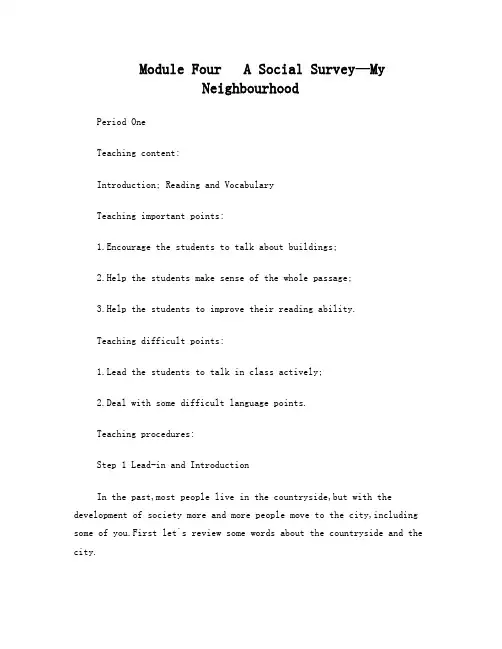
Module Four A Social Survey—MyNeighbourhoodPeriod OneTeaching content:Introduction; Reading and VocabularyTeaching important points:1.Encourage the students to talk about buildings;2.Help the students make sense of the whole passage;3.Help the students to improve their reading ability.Teaching difficult points:1.Lead the students to talk in class actively;2.Deal with some difficult language points.Teaching procedures:Step 1 Lead-in and IntroductionIn the past,most people live in the countryside,but with the development of society more and more people move to the city,including some of you.First let`s review some words about the countryside and the city.village, countryside, town, suburb, apartment(AE)/flat(BE), block, community, neighbourhoodThis module,we`ll talk about our neighbourhood.Now,please turn toP31 to learn more words about this topic.1.Activity1 on P31.2.Activity2 on P31.3.Activity3 on P31.(It can be assigned as home work.)Ask the students to write some sentences describing their homes after the example and then ask some of them to present their work to the class.Step 2 Pre-readingNext we`ll listen to the tape about Xiao Li`s hometown and choose the correct answers.(Activity1 on P33)Step 3 Reading1.Activity2 on P332.Explain some language points.(Ref: Notes to the text.)3.Read through the text carefully again to understand it better.Step 4 Consolidation[Finish Activity3-4 not referring the text to test how much the students can remember about the text after reading.]4.Activity3.5.Activity4.Step 5 Summary and Homework1.Summary: Summarize what they have learned in this period.2.Homework: Reading on P87-88 in workbook.Appendix: Notes to the text1. It’s been six years since we last s aw each other. 自从我们上次见面已经有6年了。
Module 4 A Social Survey – My Neighbourhood课标要求概览:重点单词: survey n.调查 neighborhood n . 邻居;街坊 local adj .地方的;局部的 suburb n .郊区 hometown n .家乡 pretty adv .很;相当 sound vi .听起来 tourist n .旅游者;观光者 bother vt .打扰;麻烦 nuisance n .令人讨厌的人或事 rent n .租金 district n .地区;区域 approach vt . 接近;方法 harbor n .海港 gorgeous adj .美丽的;宜人的 architecture n .建筑 starve vi .饿死 park vt . 停车 traffic n . 交通 mittee n .委员会 organization n .组织 household n .家属;家人 occupation n .职业 professional adj .专业的 manual adj .用手的;手的 gallery n .美术馆;画廊 exchange vt .交换 fascinating adj .迷人的;吸引人的 afford vt . survive v i.死里逃生;幸存 contact vt .词汇拓展: 1. fortunate(adj)幸运的→fortunately(adv .)→unfortunate 〕→fortune (n .) 2. unemployed(adj)失业的→unemploy (v .)→unemployment(n .)失业 3. tourist →tour(n .)旅游,观光→tourism(n .)旅游业 4.attractive(adj)吸引人的→attraction(n .)吸引力(u.);吸引人的事物(c.)→attract(v .) 5. starve(v .)→starvation(n .)饥饿 重点短语: 1. apartment block 公寓大楼2. be similar to 与……相似 3. on the coast 在海岸边4. by the seaside 在海滨 5. would like/love/prefer to do 愿意做某事 7. as a result 因此,结果 6. so far/ up to now/ till now 直到现在 8. such as 诸如…,例如 9. go up 上升,上涨 10. more and more 越来越…… 11. make money 挣钱 12. put up 建造,X 贴 13. get away from 摆脱 要点归纳: 1. “Her parents are farmers and have recently built a house on their land as their new house.〞 ◢as 用法小结: 1)引导状语从句: (1)“当……时候〞,引导时间状语从句 eg. As she sang, the tears ran down her cheeks. (2)“因为,由于〞,引导原因状语从句 eg. As Jim liked walking, we started off on foot. (3)“如,像〞,引导方式状语从句或比较状语从句。
高中英语外研版必修1Module 4—教学设计【教学参考】Book 1 Unit 4 Friends forever教学设计小蝌蚪找妈妈教学设计教学目标:1、知识目标:知道小蝌蚪变成青蛙的过程;2、能力目标:培养学生正确、流利、有感情的朗读课文的能力;培养学生大胆表演、质疑、想像、表达的能力;3、情感目标:了解青蛙是益虫,懂得保护青蛙。
重点难点:重点是了解小蝌蚪变成青蛙的过程;难点是分角色朗读和表演。
教具准备:头饰、课中操音乐多媒体课件教学过程:一、谜语导入,激发兴趣:亲爱的同学们,上课之前,老师先请大家猜一个谜语:1、小黑鱼,滑溜溜,圆圆脑袋长尾巴,池塘里面游呀游。
板书:小蝌蚪2、绿衣小英雄,田里捉害虫,冬天它休息,夏天它捉虫。
板书:青蛙3、小蝌蚪和青蛙之间是什么关系呢?板书:妈妈4、今天,我们就来学一个非常有趣的故事。
板书:找齐读课题:小蝌蚪找妈妈二、观看动画,理清思路:1、先请大家看这篇文章的动画片。
2、这篇课文讲了一件什么事?(1)这篇课文主要讲的是:小蝌蚪去找她的妈妈,先碰到了鲤鱼,又碰到了乌龟,最后才找到了他们的妈妈青蛙。
(2)这篇课文主要讲的是小蝌蚪怎样变成青蛙的故事。
找鲤鱼乌龟变并在田字格里指导学生写“变”字三、配乐朗读,初步感知:1、师配乐范读,学生回答:这篇课文有几个自然段?在书上标出。
2、学生配乐按自然段接读课文后,认读二类字。
灰黑色迎上去阿姨头顶披着鼓着3、小蝌蚪是怎样变成青蛙的?板书:长出后退长出前腿尾巴变短四、研读课文,理解内容:1、那蝌蚪是什么样?学习第一段帯动作表演读,突出小蝌蚪的特点,增加趣味性,加深对蝌蚪外形的认识。
2、青蛙什么样?学习第四段:采用换角色自述的方式,让孩子们进一步加深对青蛙外形的认识。
如——例:我是一只大青蛙,我头上鼓着一对大眼睛,披着碧绿的衣裳,露着雪白的肚皮,四条腿,宽嘴巴。
3、跳课中操《小青蛙找家》4、指导写“披”字5、采用分角色朗读、帯头饰表演等形式分别学习二、三、五段。
The Second PeriodThe General Idea of This PeriodIntroduce the city of Xiamen. The students will get to know where it is located. What about the climate and some other information.Teaching Aims1. Learn and master the following words and expressions:hometown, attractive, lively, seem, fortunate, pretty, a lot of tourist around, brother, nuisance, business district, put up, shopping malls, approach the harbor, gorgeous, architecture, starve, apartment block2. Train the students’ reading abil ity.3. The students will be able to know something about the city of Xiamen.Teaching Important Points1. Learn to use some useful expressions:I’m so glad you could come.What’s the climate like?That sounds great.2. Train the students’ re ading ability.Teaching Difficult PointHow to help the students understand the text.Teaching Methods1. Fast reading to get a general idea of the text.2. Asking-and-Answering to help the students understand the text.3. Pair or group work to make every student work in class.Teaching Aids1. the multimedia2. the blackboardTeaching ProceduresStep 1 GreetingsGreet the whole class as usual.Step 2 RevisionAsk the students some questions. Then show the following questions and get the students to work in pairs.1. How big is your house?2. Where is your house located?3. Is it close to your school?4. Is it close to your parents’ places of work?5. Do you like the neighbourhood?6. Do you have good neighbors?7. Are there parks or other public facilities nearby?8. Is there good public transportation?9. Are their markets and shops nearby?Ask several pairs to report their answers.Suggested answers:1. My house is very big. It’s about more than 140 square m etres. There is a big drawing room,a dinning room, a study and three sitting rooms.2. My house is located in the downtown of the city.3. Yes, it is.4. It’s near to my mother’s work place but my father’s is very far.5. Yes, I like it very much. It’s clean and beautiful.6. Yes. They are very kind and friendly. They often help each other.7. Yes. There are gyms, beautiful parks and some other facilities.8. Yes, it’s convenient.9. Yes. There are many supermakets nearby.Step 3 PresentationT: Today we are going to learn a dialogue between Xiao Li and John Martin.First let’s learn some new words.(Show the words on the screen give the students a briefhometown, attractive, lively, seem, fortunate, pretty, a lot of tourist around,brother, nuisance, business district, put up, shopping malls, approach the harbor, gorgeous, architecture, starve, apartment block, be made of(Then get the Ss to make sentences with the words or phrases. For example)1. hometown: Xuzhou is my hometown.His hometown is Shanghai.2. attractive adj. (attract v. attraction n.)There are a lot of attractive places in this country.3. a lot of tourists aroundIn my hometown there are a lot of tourists around every day.4. be made of/from, be made into成品+be made of+材料(本质不变)成品+be made from+材料(本质变)材料+be made into+成品e. g. Wine is made from grapes.Grapes are made into wine.The table is made of wood.T: Now let’s look at this picture.(Show the picture of Gulangyu Island. )T: Is it beautiful?S: Yes.T: Do you know where it is?S: Sorry.(...)T: OK. Listen to the tape about the place and try to get as much information as possible about this place. you’ve to an swer me some questions.(Play the tape. After playing, ask the questions.)T: Where is John Martin visiting?S: Xiao Li’s hometown.T: Very good. Where does Xiao Li live?S: He lives in Xiamen.T: Excellent! What are John and Xiao Li doing now?S: They’re driving around the city in the car.T: Good! Who can tell us which place they are going to visit next?S: Gulangyu Island.Step 4 ReadingT: OK. Now open your books. Look at the dialogue on Page 32.Please practise the dialogue in pairs.(After a while, Get the students to look at these statements. Say “true” or “false” according to the dialogue.)1. John and Xiao Li haven’t seen each other for six years.()2. John has never been to China before.()3. Xiao Li enjoys living on the coast.()4. There are very few tourists in the northwest of Xiamen.()5. There are a lot of new high rise buildings in Gulangyu Island. ()6. There are some interesting buildings on Gulangyu Island. ()Step 5 Practice(Get the students to read the dialogue aloud. Then get the students to work in pairs. Close the textbooks and answer some questions.)T: Please discuss the questions in pairs.1. What do you know about Xiamen?2. Would you like to live in Xiamen? Why or why not?(After a while get several pairs to report their answers.)S: What do you know about Xiamen?S: I know Xiamen is on the coast. It’s a beautiful city.S: Would you like to live in Xiamen?S: Yes.S: Why?S: Because I like water. I like sea. There are some great shopping malls. I can buy more beautiful dress. I can often go to Gulangyu Island. It’s a gorgeous island with some really interesting architecture.I’m so gla d you could come.What’s the climate like?That sounds great.(If necessary, give some explanation.)Step 6 HomeworkT: Today we have learned a dialogue about Xiamen. It’s very interesting.After class you should read the dialogue again and again. And remember the new words.Reading A Lively City1.hometown Xuzhou is my hometown.His hometown is Shanghai.(扩展:homework homeland homesick homelike homemade)2. attractive There are a lot of attractive places in this country.(扩展:attract v. attraction n.)3. A lot of tourists around In my hometown there are a lot of tourists around every day.The news got like a prairie fire.Step Ⅷ Activity and InquiryXiamen My hometown Similarities climate It’s hot and wet in summer. It rains a lot in summer.position Both are on the coast.Differences climate In winter it is mid. Butsometimesit can be very cold. It’s very cold in winter. Every year it snows a lot. We skate on real ice.position It’s a big open city. There are alot of tall buildings. There aremany tourists around. It’s in the countryside. There are few tourists. But it’s also beautiful. Everywhere is clean. The air is fresh。